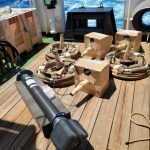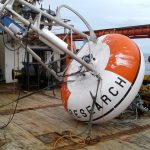 The Korea Institute of Ocean Science and Technology (KIOST) recently hosted NOAA’s Pacific Marine Environmental Laboratory (PMEL) on a cruise to re-establish and maintain the Research Moored Array for African-Asian-Australian Monsoon Analysis and Prediction (RAMA). The KIOST-NOAA joint cruise is the first RAMA maintenance cruise in the Indian Ocean since 2019, prior to the start of the COVID-19 pandemic. The cruise departed Port Louis, Mauritius on board the KIOST ship R/V ISABU on December 15, 2021 and ended in Jangmok-myeon, Republic of Korea on January 18, 2022.
The Korea Institute of Ocean Science and Technology (KIOST) recently hosted NOAA’s Pacific Marine Environmental Laboratory (PMEL) on a cruise to re-establish and maintain the Research Moored Array for African-Asian-Australian Monsoon Analysis and Prediction (RAMA). The KIOST-NOAA joint cruise is the first RAMA maintenance cruise in the Indian Ocean since 2019, prior to the start of the COVID-19 pandemic. The cruise departed Port Louis, Mauritius on board the KIOST ship R/V ISABU on December 15, 2021 and ended in Jangmok-myeon, Republic of Korea on January 18, 2022.
The primary NOAA objectives during this cruise were to recover and deploy three RAMA moorings at 12°S, 67°E; 8°S, 67°E; and 4°S, 67°E, to deploy one subsurface ADCP mooring at 8°S, 67°E, twenty Global Drifter Program (GDP) drogued-drifters, and six Argo profiling floats along the cruise track.
The moored buoy at 8°S, 67°E is particularly noteworthy because it targets the unique and highly consequential Seychelles-Chagos Thermocline Ridge (SCTR) region in the southwest tropical Indian Ocean. The SCTR is an upwelling driven doming of the thermocline that results from the hemispheric asymmetry in monsoon wind forced Indian Ocean circulation. It influences seasonal rainfall over south Asia, is the spawning ground of the Madden-Julian Oscillation (MJO) that affects weather worldwide, and is a major foraging region for tuna. This buoy is a heavily instrumented flux reference site with enhanced meteorological and subsurface sensors to observe this unique area, which is among the most promising targets for improving long range weather forecasts at subseasonal to seasonal (S2S) time scales.
There were a number of significant challenges to overcome prior to this cruise, including additional COVID-19 protocols and shipping delays. During the cruise, the crew learned that the newly deployed mooring at 4°S, 67°E went adrift. Due to the tight scheduling and timeline for re-fueling, the R/V ISABU was unable to return to recover and re-deploy this mooring. Yet, one of the many great strengths of GOMO and the Data Buoy Cooperation Panel is supporting buoy programs across many nations through international cooperation to serve a common purpose of maintaining the data buoy networks. Fortunately, the NOAA RAMA team connected with RDML Tim Gallaudet, who was able to connect them with the UK National Hydrographer, and on January 19, Grampian Frontier, a UK Supply Vessel in the region, successfully recovered the drifting buoy.
RAMA Program Manager, Sid Thurston noted that the RAMA team from PMEL went “above and beyond to successfully work side-by-side with their Korean colleagues to plan logistics and execute flawlessly to service RAMA Moorings. We thank our colleagues who are working tirelessly to keep Indian Ocean data flowing freely to, among others, improve MJO, monsoon and S2S forecasts around the world, including for the USA.”


